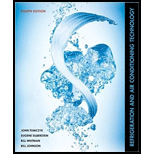
Bundle: Refrigeration And Air Conditioning Technology, 8th + Lab Manual + Lms Integrated For Mindtap Hvac-r, 4 Terms (24 Months) Printed Access Card
8th Edition
ISBN: 9781337087315
Author: John Tomczyk, Eugene Silberstein, Bill Whitman, Bill Johnson
Publisher: Cengage Learning
expand_more
expand_more
format_list_bulleted
Concept explainers
Textbook Question
Chapter 33, Problem 7RQ
The "point of no pressure change" is located at the
A. outlet of the circulator pump.
B. inlet of the expansion tank.
C. inlet of the pressure-reducing valve.
D. outlet of the pressure relief valve.
Expert Solution & Answer
Want to see the full answer?
Check out a sample textbook solution
Students have asked these similar questions
b = 25
y
t = 2
a=10
C = 25
Solve this problem and show all of the work
Solve this problem and show all of the work
Chapter 33 Solutions
Bundle: Refrigeration And Air Conditioning Technology, 8th + Lab Manual + Lms Integrated For Mindtap Hvac-r, 4 Terms (24 Months) Printed Access Card
Ch. 33 - A hydronic heating system uses ______to move heat...Ch. 33 - Describe a zone in a hydronic heating system.Ch. 33 - Name four sources of heat commonly used for...Ch. 33 - Give three reasons that air is detrimental to a...Ch. 33 - Explain the difference between a wet-base and a...Ch. 33 - Where is air vented from a hydronic heating...Ch. 33 - The "point of no pressure change" is located at...Ch. 33 - The purpose of a limit control in a boiler is to...Ch. 33 - The device that relieves the pressure in a boiler...Ch. 33 - Describe the function of a low-water cutoff.
Ch. 33 - The relief valve setting for a typical...Ch. 33 - Describe how an air cushion tank functions in a...Ch. 33 - True or False: City water does not contain air.Ch. 33 - State two ways that air can get into a hydronic...Ch. 33 - The most common type of pump used for hydronic...Ch. 33 - Another term for pump pressure is feet of _______.Ch. 33 - Two types of zone control valves are the _____and...Ch. 33 - Why must expansion be considered when sizing...Ch. 33 - How is expansion in hot water pipes handled?Ch. 33 - Sketch the following systems: one pipe, two-pipe...Ch. 33 - Describe the advantage of a two-pipe...Ch. 33 - The pressure differential bypass valve is most...Ch. 33 - What is the heat output, in Btu/h, of a terminal...Ch. 33 - In a primary-secondary pumping arrangement, the...Ch. 33 - The temperature of the water at the outlet of a...Ch. 33 - A tankless water-heating system gets its heat from...Ch. 33 - How much of the sun's energy actually reaches the...Ch. 33 - The varying intensity of the sun's energy that...Ch. 33 - Drain-down systems would best be used in which...Ch. 33 - Why are solar systems intended to be used as a...
Knowledge Booster
Learn more about
Need a deep-dive on the concept behind this application? Look no further. Learn more about this topic, mechanical-engineering and related others by exploring similar questions and additional content below.Similar questions
- No chatgpt pls will upvotearrow_forwardreading is 0.4 mas SHOWN. Assume h₁ = 0.4 m, h₂ = 0.5 m. (a) Do you know the specific weight of mercury? (b) Do you know the specific weight of gasoline? (c) Do you know the specific weight of oil? (a) YHg = 133,000 (b) Ygas = 6867 (c) Yoil = 8829 eTextbook and Media Part 2 N/m³ N/m³ N/m³ A+ Gasoline t +B Oil -Mercury Attempts: unlimited Did you calculate the pressure difference between two locations using the correct specific weight? Did you assume that the pressures in fluid are the same in a horizontal plane even though they are in different tubes? Are the calculated pressures in a column of fluid always higher at lower elevations? Did you account for the fact that the two horizontal tubes of the U-tube are above the ground? Concepts: The pressure in a fluid is a function of the specific weight of the fluid and the height relative to a reference. Pressure is constant in a horizontal plane of a continuous mass of fluid. (a) What is the initial pressure difference? (PA-PB) (b) What is…arrow_forwardFind the solution of the following Differential Equations 1) "-4y+3y=0 3) "+16y=0 2) y"-16y=0 4) y"-y-6y=0 5) y"+2y=0 7) y"+y=0, (#0) 9) y"-y=0, y(0) = 6, y'(0) = -4 11) y"-4y+3y=0, y(0)=-1, 13) y'(0) = -5 "+2y+2y=0 15) y"-9y=0 17) y"-4y=0 6) y"-2y+2y=0 8) "+4y+5y=0 10) y"-9y=0, y(0) = 2, y'(0) = 0 12) y"-3y+2y= 0, y(0)=-1, y'(0) = 0 14) 4y+4y+y=0 16) "+6y+12y=0 18) 4y+4y+17y=0arrow_forward
- Access Pearson Mastering Engineering Back to my courses Course Home Course Home Scoresarrow_forwardAccess Pearson Mastering Engineering Back to my courses Course Home Course Home Scores Review Next >arrow_forwardAccess Pearson Course Home Scoresarrow_forwardCan you answer this question?arrow_forwardCan you answer this question?arrow_forwardA gear has a gear wheel with 16 teeth. The gear should be dimensioned for the highest and lowest gear ratio. Looking for output power, torque, speed?nin= 2000 rpmmin = 30Nmn=0,9a max= 450 mmModule 4Gear limitsz1 z213 13-1614 14-2615 15-4516 16-10117 17-131418 18-…..I have calculate but I can’t get the right answers…..√16 =459x60/56x57=1.1 lowest59x60/13x13=20,94 highestnut=2000/1.1= 1818rpmnut=2000/20.94=95.5 rpmMut=1.1x30=33 NmMut=20.94x30=628,2 Nm(Right answer)LowestZ=13, M=24,4Nm, n=2462 rpmHighestZ=92, M=172,5Nm, n=347,8 rpmP=5655W on botharrow_forwardarrow_back_iosSEE MORE QUESTIONSarrow_forward_ios
Recommended textbooks for you
 Refrigeration and Air Conditioning Technology (Mi...Mechanical EngineeringISBN:9781305578296Author:John Tomczyk, Eugene Silberstein, Bill Whitman, Bill JohnsonPublisher:Cengage Learning
Refrigeration and Air Conditioning Technology (Mi...Mechanical EngineeringISBN:9781305578296Author:John Tomczyk, Eugene Silberstein, Bill Whitman, Bill JohnsonPublisher:Cengage Learning Welding: Principles and Applications (MindTap Cou...Mechanical EngineeringISBN:9781305494695Author:Larry JeffusPublisher:Cengage Learning
Welding: Principles and Applications (MindTap Cou...Mechanical EngineeringISBN:9781305494695Author:Larry JeffusPublisher:Cengage Learning

Refrigeration and Air Conditioning Technology (Mi...
Mechanical Engineering
ISBN:9781305578296
Author:John Tomczyk, Eugene Silberstein, Bill Whitman, Bill Johnson
Publisher:Cengage Learning

Welding: Principles and Applications (MindTap Cou...
Mechanical Engineering
ISBN:9781305494695
Author:Larry Jeffus
Publisher:Cengage Learning
Fluid Mechanics - Viscosity and Shear Strain Rate in 9 Minutes!; Author: Less Boring Lectures;https://www.youtube.com/watch?v=_0aaRDAdPTY;License: Standard youtube license